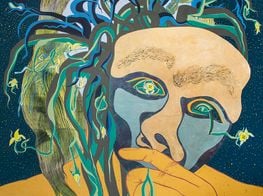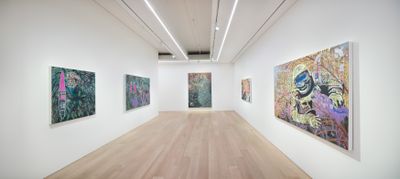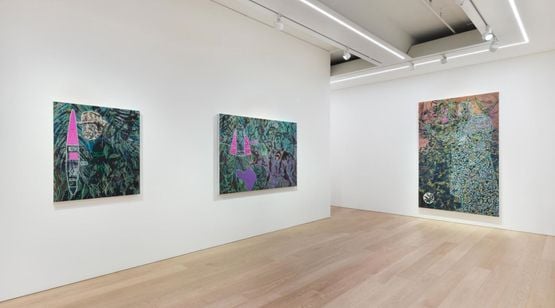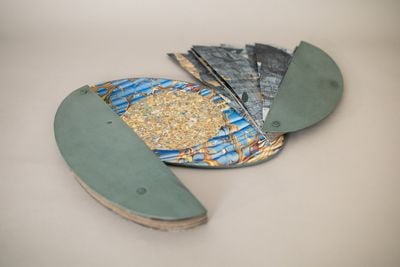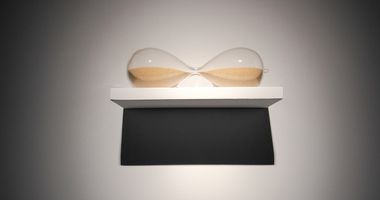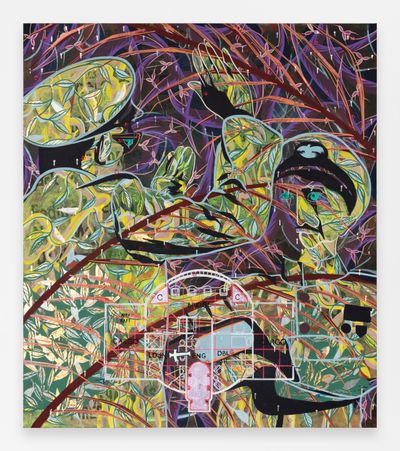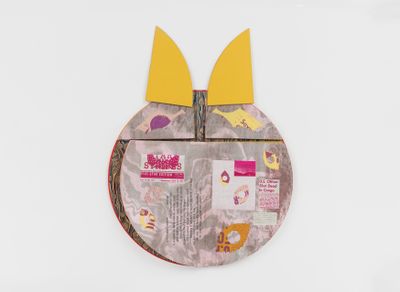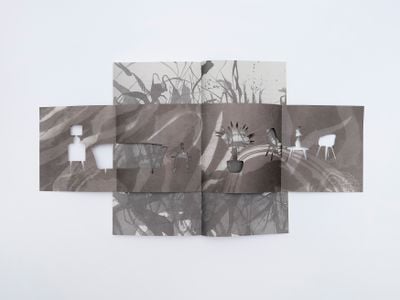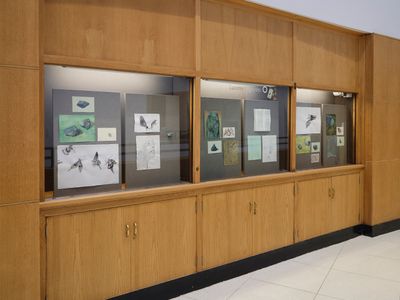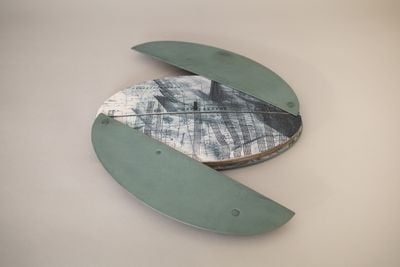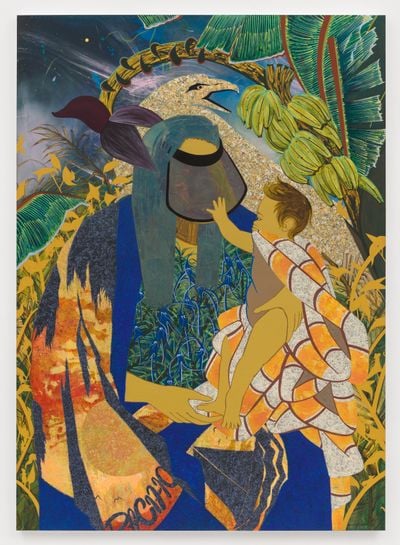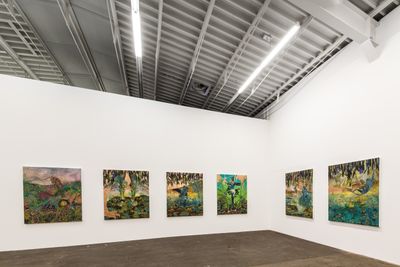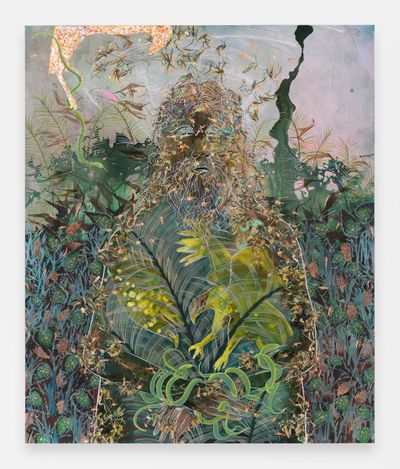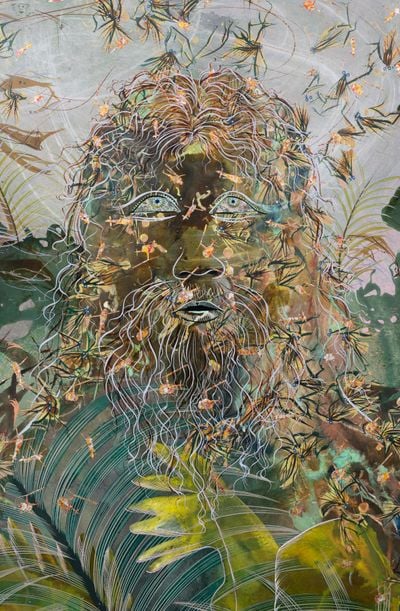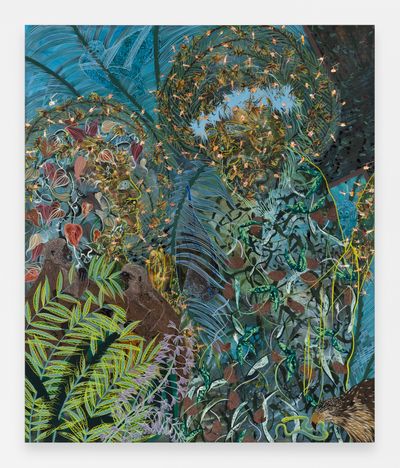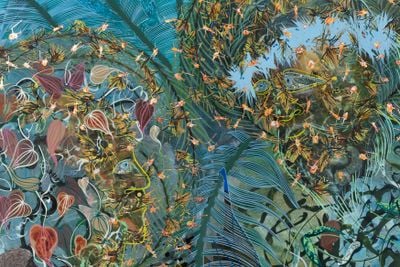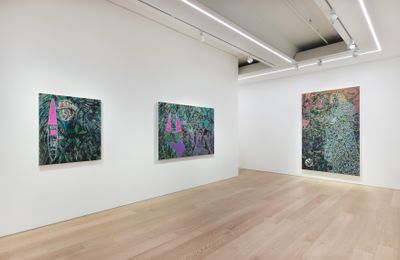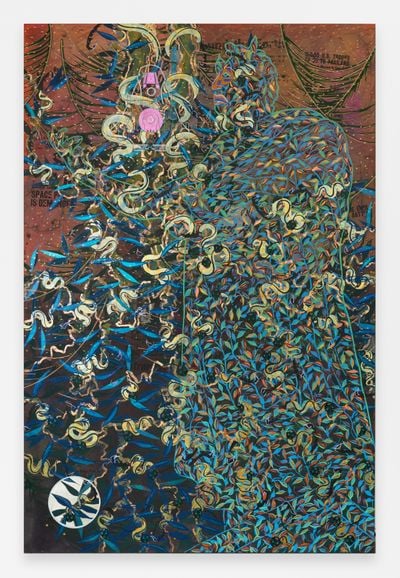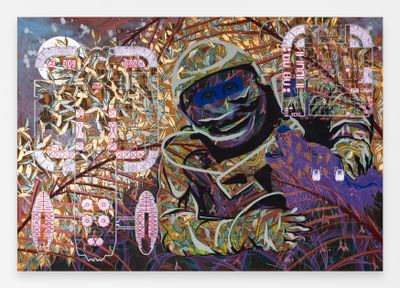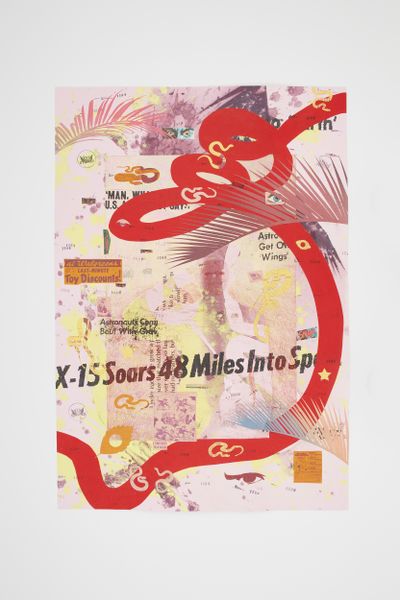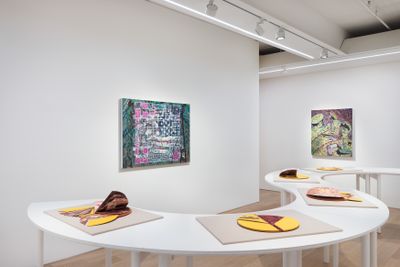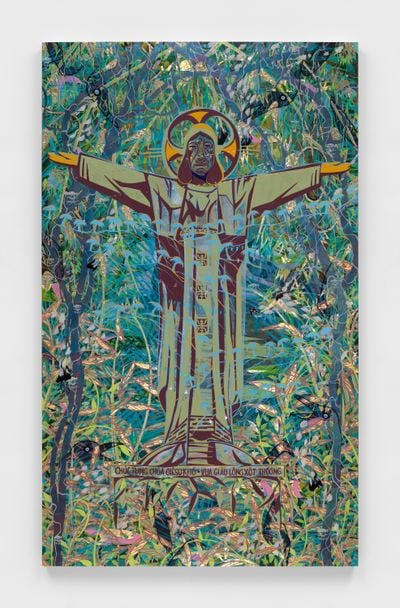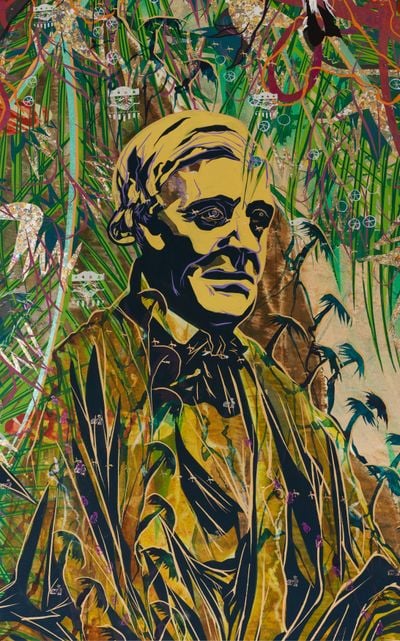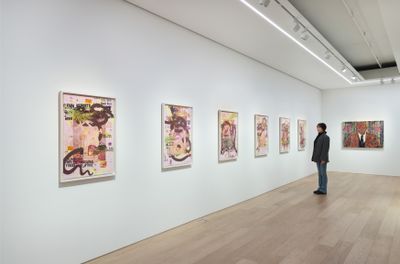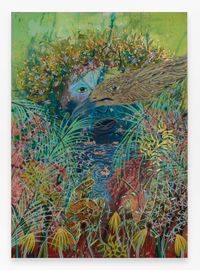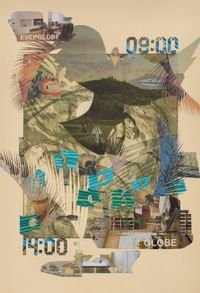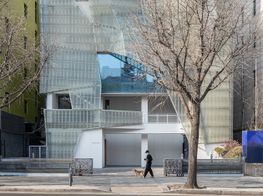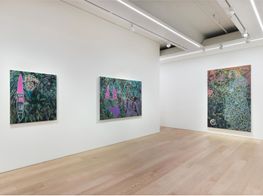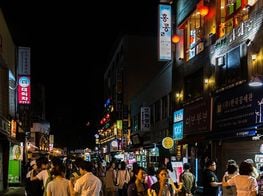Tammy Nguyen's Tropical Infernos
Tammy Nguyen in her studio (2022). Courtesy the artist and Lehmann Maupin, New York/Hong Kong/Seoul/London. Photo: Annie Ling.
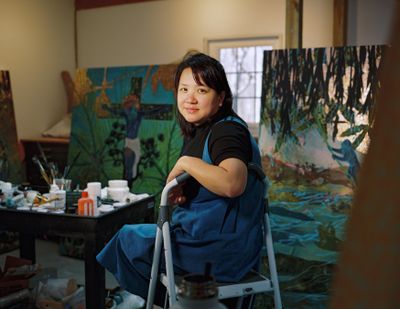
Tammy Nguyen in her studio (2022). Courtesy the artist and Lehmann Maupin, New York/Hong Kong/Seoul/London. Photo: Annie Ling.
What is a farm but a mute gospel? It is this question, originally posed in 1836 by Ralph Waldo Emerson in his essay 'Nature', that the Vietnamese-American artist Tammy Nguyen revisits in her first U.S. solo museum presentation.
Tammy Nguyen at ICA Boston (24 August 2023–28 January 2024) continues the Connecticut-based artist's collapsing of disparate historic, religious, and personal narratives.
Emerson was a proponent of transcendentalism, a 19th-century philosophical movement emerging from the New England region of the U.S. that professed the inherent goodness and divinity of nature and people. Nearly 200 years after 'Nature' was written in Concord, Massachusetts, Nguyen draws out its thematic underpinnings in relation to colonialism and land reformation during the Vietnam War.
Nguyen is a maker of books, paintings, drawings, and prints. Alongside her studio practice, Nguyen has asserted a place in art publishing, founding independent imprint Passenger Pigeon Press in 2016 as well as developing her own artist books.
Since graduating from The Cooper Union (2007) and Yale School of Art (2013), Nguyen has exhibited widely in the U.S. and Asia. Her career continues to attract international recognition, with recent solo exhibitions at Lehmann Maupin Seoul (2023), Brooklyn Public Library (2022), and Nichido Contemporary Art, Tokyo (2022). Among recent group exhibitions, she has exhibited at the Thomas J. Watson Library in The Metropolitan Museum of Art (2022) and MoMA PS1 (2021). This September, Nguyen will feature in a group exhibition at the Weatherspoon Art Museum in North Carolina.
Recent publications include the four-part collection Four Ways Through a Cave (2021) and the monograph O (2022), both of which blend myth and recollections of the artist's visit to the Phong Nha caves in Vietnam. While O takes a more conventional approach to book-making—a slim volume with fold-out sheets, text, and artist illustrations—Four Ways Through a Cave is constructed as three-dimensional, almost sculptural arched forms.
For the 12th Berlin Biennale for Contemporary Art in 2022, Nguyen presented 14 large-scale abstract paintings based on the Stations of the Cross—a series of 14 images detailing events in the Passion of Christ—to widespread acclaim. Most recently she was announced as a 2023 Guggenheim Fellow along with artists Kapwani Kiwanga, Martine Syms, and Pamela Council, among others.
In March, Nguyen opened her first solo exhibition with Lehmann Maupin in Seoul. A Comedy for Mortals: Inferno (23 March–6 May 2023) commenced the first of Nguyen's exhibition series based on Italian poet Dante Alighieri's 14th-century Divine Comedy, a narrative poem envisaging the afterlife through descriptions of Dante's travels through Hell, Purgatory, and Heaven.
Inferno comprised a suite of new mixed-media paintings made on large panels laminated and stretched over with paper—a ground that provides a porous surface to showcase the fluid materiality of watercolour inks and matte vinyl paints. Further works on paper and artist books unfolded a puzzling repertoire of imagery relating simultaneously to Christian and Catholic narratives, Cold War histories, and Southeast Asian geography.
Her series of nine circular books lent a different way of engaging in Inferno. Nguyen's characteristic innovative publication design is seen in red leather covers, multiple fold-out 'wings', and use of techniques such as letterpress printing, laser cutting, collage, and intaglio.
Mirroring the three parts of Dante's epic (Inferno, Purgatorio, and Paradiso), Nguyen's Comedy for Mortals will unfold as three exhibitions over three years, continuing in London with A Comedy for Mortals: Purgatorio in March 2024, and culminating in 2025 with A Comedy for Mortals: Paradiso in New York.
Ahead of her ICA Boston opening, Nguyen discusses with Ocula Magazine the research that has informed her ambitious new show. Breaking down references from the Space Race to the Singapore Strait, the Vietnam War to Ralph Waldo Emerson, Nguyen imagines parallels between historic quests into space, medieval storytelling, and postwar legacies.
OMWhile the format of the artist's book is often seen as supplementary to a body of artworks, you have experimented with publication as an integral part of your practice, as with your artist book O (2022), published by Ugly Duckling Presse, and your four-part book collection Four Ways Through a Cave (2021). Both expand upon the book format to become interactive conceptual objects in themselves. Can you talk about the ideas that drove these projects?
TNA lot of my work is an exploration of language and how language changes, transforms, and holds many different meanings. The book O is called O in part cause 'o' acts as both an image and an opening.
'O' is round—it's a portal as well as a sound. It's also a letter. As I take you through this journey of playing with the letter 'o', I'm also using it to describe personal stories and descriptions of different locales across Asia that I put together to explore and contemplate ideas about truth and beauty.
One of the places I wrote about in O was Forest City, a manmade island that exists between Singapore and Malaysia. As a tax haven and place of plentiful food and drink and shopping, it has been lauded as a utopian paradise, and was a really interesting place to write about and experience.
Another place that I explore in O is the cave systems within karst terrains across Vietnam, Laos, and Cambodia. While I was writing O, I made Four Ways Through a Cave, a series of four books that tell four different experiences of travelling through the Phong Nha-Kẻ Bàng caves.
One of the reasons I became interested in Phong Nha was for its spectacular geography and the difficulty of navigating the space. I went splunking to experience what it's like to be in the different hollows, swimming in the caves and climbing the different rocks.
It was also interesting historically, because Phong Nha was the site of the Ho Chi Minh Trail, which was a system of communication and transportation amongst porters and other folks who were loyal to the Northern cause [intent to unify North and South Vietnam under communism]. I became interested in how the system was credited for being a unification force for the Vietnamese northern communist army.
Four Ways Through a Cave is also about Plato's Allegory of the Cave. In Plato's allegory, a freed prisoner exits a dark cave and in his discovery of reality outside, finds a whole new meaning of truth. Reading Plato's allegory was a really interesting way for me to ask questions about what truth is in relationship to our own experiences.
OMAllegorical and religious references have entered your paintings, in both subject and thematic continuity. This is especially evident in your works such as In the Heart of Rimland (2021), an abstracted, fantastical depiction of the Madonna and Child, which invariably draws comparisons to Duccio's Madonna and Child (c. 1290–1300).
Your 14 paintings exhibited at the 12th Berlin Biennale inhabited the structure of the Stations of the Cross, and most recently, your show at Lehmann Maupin Seoul deployed Dante's Inferno as a guiding framework. Could you talk about your relationship to religion and its place in your practice?
TNAfter writing about Forest City in O, I started to think a lot about scripture, and of scripture entering the realm of capitalism and modernity. In the Heart of Rimland is a result of those questions. This image of the Madonna and Child began as a longer exploration of ideas of Christianity and Catholicism in a postcolonial imagination.
I was thinking a lot about the legacies of colonialism and what it means to find salvation in a religion that has simultaneously caused a lot of erasure. That contradiction became important to me.
In the sequence of 14 paintings for the Berlin Biennale, the foreground stories are those of Jesus being nailed to the cross, buried, and resurrected. I was thinking a lot about the legacies of colonialism and what it means to find salvation in a religion that has simultaneously caused a lot of erasure. That contradiction became important to me.
OMThese works also contain other disparate narratives. Can you talk about these?
TNI'm interested in collapsing narratives into one another. I often use the structure of one larger narrative and then squeeze other narratives inside of it. I would approach making a body of work like 'Stations of the Cross' by breaking up the paintings into different groups, where there are other subsets of stories that I pull from different places, including my imagination, curiosities, and aspects of history.
In the background of the story depicting the Stations of the Cross is my own fantastical version of the Singapore Strait, which my parents once traversed. The Strait is the main pathway for freight ships in Singapore—it's how goods are brought in from the Middle East, entering the bay through the Strait of Malacca, and into Singapore, then up towards the rest of Asia. This passageway has been an inspiration for a lot of my work.
There is also a story about a Catholic worship area within a former refugee island called Galang Island, which is very close to Kuku Island, where my parents were refugees. Galang Island is not far from Singapore. You can actually hear the radio from Singapore on the island. This became an interesting story that I wanted to fold into my exploration of the Stations of the Cross.
My parents don't talk much about the war. It's also really difficult for me to ask them questions about it, so anytime I hear a story, I really hang onto it and savour it. One story that struck me, and that has come back again and again in my work, is a story that my father told me about when he was out at sea on the fishing boat that they took to find freedom.
He told me that one of the most traumatic things about being at sea was the sun. The sun was beaming so much, and of course they couldn't drink any of the water, despite being surrounded by it. He was going crazy because it was so hot.
There were a lot of freight ships passing them, and one sprayed his boat with water, offering all of the people on board a sense of relief. I think that saved his life, in a way. That story was always really striking to me, especially as I began my research, and then living in Vietnam and visiting the surrounding countries.
OMCould you talk about your painting process, and how you work with materials?
TNLocking in the composition is an important part of my artistic process. Once this happens, it provides me with a sense of freedom to insert more and more stories as I develop the images. A lot of the paintings start out as big washes of colour—I do that as a way to create an environment. As I continue to work, the details come into fuller and fuller clarity.
I'm interested in the way that light is reflected onto the paintings. Their surfaces are mostly made up of matte paints, but illuminated with different metals ranging from coppers, pigmented silvers and golds. Because the gilding, and sometimes the tooling, is so flat on the surface, when light shines on it, the paintings appear somewhat sculptural despite being extremely flat. That luminosity is something that I find really intriguing, as a way to explore space and the making of environments.
I often create gradations of tone through the pores and washes of watercolour and ink. Beyond that, I'm interested in creating space through line and shape. I'm excited by the possibility of creating deep space without actually rendering it. All space is then created through the juxtaposition of line, colour, and shape.
OMDante's Divine Comedy provides an overarching framework for your three-part exhibition series that began with Inferno at Lehmann Maupin Seoul, which included new paintings, works on paper, and a series of artist books. How did your research into Dante's story arise?
TNI'm really interested in collapsing stories of contradiction. I think at the root of it is a fascination with moral ambiguity—these paradigm shifts of how someone adopts a religion or an ideology, for example. It culminated in A Comedy for Mortals: Inferno.
What this particular show aimed to deconstruct, reconstruct, and then reimagine as a totally new world was the main narrative of Dante's Inferno, which is Dante and Virgil's descent into the Nine Circles of Hell. I presented this descent as analogous to an ascent into space. Both destinations—hell and space—are presented as extremely torrid, mysterious, and dismal.
One of the reasons I became interested in Dante was because of Virgil, a Roman poet and Dante's guide through Hell. There are some scholars who think that when Virgil was writing the Aeneid, he knew that Christ was coming. I had just finished making these paintings about the Stations of the Cross, and with the Divine Comedy being a very Christian story, it seemed like an epic that was worth my time to unpack and fold into the rest of my brain and thinking.
One of the most inspirational images in Dante's Inferno is the conclusion where Dante and Virgil exit Hell and see the stars. That became such a poetic starting point because it reflects the planet, physical space, and time collapsing together.
OMYour paintings and works on paper in A Comedy for Mortals: Inferno contained a lot of found and archival imagery seemingly unrelated to Dante—in Leading the Way (2023), one can glean the headline, 'U.S. Troops to go to Thailand'. There are a lot of images of spacecrafts and references to Cold War histories. How do you incorporate archival media and research images into your compositions?
TNTo make the analogy between a descent into Hell and an ascent into space more vivid and tactile, I started to compare Dante's Inferno to the Space Race during the Cold War. I did a lot of research into the Stars and Stripes newspaper, an American newspaper based out of Japan and distributed to military personnel based in Vietnam. That kind of information distribution became really fascinating to me.
I went into the archives of Stars and Stripes and downloaded every single front page that had anything to do with the Space Race. What I found so striking was that not only did the newspaper cover the Space Race with enthusiasm, but there were also all these other Cold War conflicts that were happening at the same time, inspiring a way to create a hell on Earth.
I created a ground made of headlines. You can see 'Space Comrades Land as Heroes' in the background. Then there are swarms of helicopters that could also be mosquitoes, and the little dates and stamps and stuff like that, which place my interpretation of Dante's Inferno into the theatre of the Cold War.
... it is extremely advantageous for a space launch to occur as close to the equator as possible, to take advantage of the earth's rotational spin. I thought that was so beautiful, as a way to place Hell into the tropics.
Throughout the paintings in the show, and the works on paper and artist books, there are spaceships that were computer generated. They each offer a different dynamic blueprint for a possible military spacecraft. The paintings have those spacecrafts in them, but then the subjects of each painting zero in on a particular conflict that was happening somewhere in the world during the frenzy of the Space Race.
One work called When Bitten by Fleas (2023) is based off a 1963 image by American photojournalist Bill Hudson showing a dog biting a Black man. In the photograph, there's this clear tension between the police and the Black man. This is an image that really hit a note and is an expression of the racial strife and conflicts that were happening in Alabama at the time.
I took this image—there were many other conflicts featured in the show—and put it into this torrid world of the tropics that I'm using to describe Hell. I found out that it is extremely advantageous for a space launch to occur as close to the equator as possible, to take advantage of the earth's rotational spin. I thought that was so beautiful, as a way to place Hell into the tropics.
The works on paper in Inferno all began from a bunch of NASA images that I downloaded, which capture earth as seen from outer space. Other images include a volcano in Indonesia, a solar eclipse in the South Pacific, and a photograph of Lyndon B. Johnson, who was instrumental in the Space Race.
There is also a photograph of John F. Kennedy at Cape Canaveral with Wernher von Braun, who was a former Nazi scientist who was brought to America and somewhat forgiven because of his expertise in building rockets. These were all pulled from an arsenal of images taken during the Cold War.
OMWhat about your book series in Inferno?
TNIn a way they represent the Nine Circles of Hell, but they could also be perceived as nine different planets, nine different ideas of the sun, or of the moon. They all started with this red half-moon shape. When you open them, they look like little spaceships. They open up like a bug or a beetle, then all of these other pages come out.
I'm excited by the possibility of oscillating between foreign policy and poetry. Is it possible to hold all of that information together?
There are texts that can be read in multiple directions, whether sideways or through opening combined texts, including stanzas from Inferno and elements from the Stars and Stripes newspaper describing different conflicts from the Cold War.
OMYour solo show at ICA Boston is the result of a continuation of this research into postwar histories and Vietnam-U.S. relations. Could you talk about this process?
TNI'm interested in postwar histories related to the Vietnam War because of my lineage and diasporic context. That said, my interests in the world are vast—I am curious about the environment, mythologies from different places, people from different cultures...
I keep a lot of ideas stewing in the back of my mind, but in general, my studio practice is very much like putting one foot in front of the other. When an opportunity arises, I go into my 'ideas archive' and see if it is time to bring one out and give it life in the studio.
OMHow did you first come across Ralph Waldo Emerson's essay 'Nature', a source that strongly informed the development of your ICA Boston show, and how did you see it relating to your existing parallel research?
TNI first read 'Nature' in high school and was inspired by the American transcendentalist movement. I think I was compelled by the movement's ideas of self-reflection and looking within to create a sense of God and spirituality.
In the last few years, I have explored ideas of land and the environment, particularly how a person's identity is extended through 'working' the land. This has now become an investigation into Manifest Destiny [19th-century belief in the expansion of American settlers as a God-ordained right], which is related to my interest in the transcendentalists of my teenage years.
OMWhat sort of connection do you see your paintings, works on paper, and books having between each other in a show?
TNWhenever I'm thinking about a body of work, there is a kind of trinity between the bodies of work that come together—mainly artist books, works on paper, and painting. I like them coming together because I'm interested in how the languages rub up on each other.
I'm excited by the possibility of oscillating between foreign policy and poetry. Is it possible to hold all of that information together? —[O]

